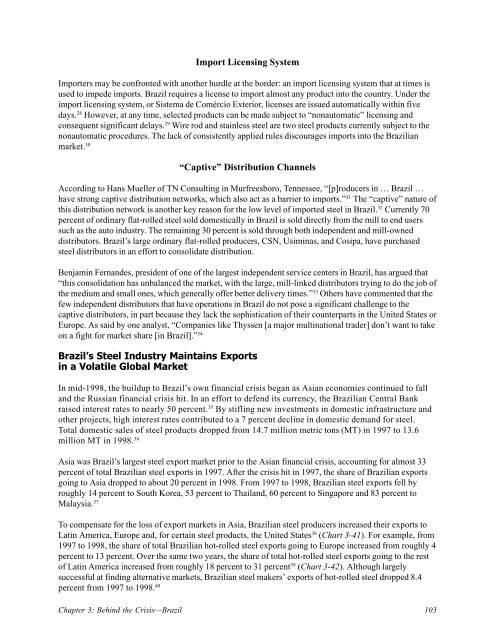Global Steel Trade; Structural Problems and Future Solutions
Global Steel Trade; Structural Problems and Future Solutions
Global Steel Trade; Structural Problems and Future Solutions
You also want an ePaper? Increase the reach of your titles
YUMPU automatically turns print PDFs into web optimized ePapers that Google loves.
Import Licensing System<br />
Importers may be confronted with another hurdle at the border: an import licensing system that at times is<br />
used to impede imports. Brazil requires a license to import almost any product into the country. Under the<br />
import licensing system, or Sistema de Comércio Exterior, licenses are issued automatically within five<br />
days. 28 However, at any time, selected products can be made subject to “nonautomatic” licensing <strong>and</strong><br />
consequent significant delays. 29 Wire rod <strong>and</strong> stainless steel are two steel products currently subject to the<br />
nonautomatic procedures. The lack of consistently applied rules discourages imports into the Brazilian<br />
market. 30<br />
“Captive” Distribution Channels<br />
According to Hans Mueller of TN Consulting in Murfreesboro, Tennessee, “[p]roducers in … Brazil …<br />
have strong captive distribution networks, which also act as a barrier to imports.” 31 The “captive” nature of<br />
this distribution network is another key reason for the low level of imported steel in Brazil. 32 Currently 70<br />
percent of ordinary flat-rolled steel sold domestically in Brazil is sold directly from the mill to end users<br />
such as the auto industry. The remaining 30 percent is sold through both independent <strong>and</strong> mill-owned<br />
distributors. Brazil’s large ordinary flat-rolled producers, CSN, Usiminas, <strong>and</strong> Cosipa, have purchased<br />
steel distributors in an effort to consolidate distribution.<br />
Benjamin Fern<strong>and</strong>es, president of one of the largest independent service centers in Brazil, has argued that<br />
“this consolidation has unbalanced the market, with the large, mill-linked distributors trying to do the job of<br />
the medium <strong>and</strong> small ones, which generally offer better delivery times.” 33 Others have commented that the<br />
few independent distributors that have operations in Brazil do not pose a significant challenge to the<br />
captive distributors, in part because they lack the sophistication of their counterparts in the United States or<br />
Europe. As said by one analyst, “Companies like Thyssen [a major multinational trader] don’t want to take<br />
on a fight for market share [in Brazil].” 34<br />
Brazil’s <strong>Steel</strong> Industry Maintains Exports<br />
in a Volatile <strong>Global</strong> Market<br />
In mid-1998, the buildup to Brazil’s own financial crisis began as Asian economies continued to fall<br />
<strong>and</strong> the Russian financial crisis hit. In an effort to defend its currency, the Brazilian Central Bank<br />
raised interest rates to nearly 50 percent. 35 By stifling new investments in domestic infrastructure <strong>and</strong><br />
other projects, high interest rates contributed to a 7 percent decline in domestic dem<strong>and</strong> for steel.<br />
Total domestic sales of steel products dropped from 14.7 million metric tons (MT) in 1997 to 13.6<br />
million MT in 1998. 36<br />
Asia was Brazil’s largest steel export market prior to the Asian financial crisis, accounting for almost 33<br />
percent of total Brazilian steel exports in 1997. After the crisis hit in 1997, the share of Brazilian exports<br />
going to Asia dropped to about 20 percent in 1998. From 1997 to 1998, Brazilian steel exports fell by<br />
roughly 14 percent to South Korea, 53 percent to Thail<strong>and</strong>, 60 percent to Singapore <strong>and</strong> 83 percent to<br />
Malaysia. 37<br />
To compensate for the loss of export markets in Asia, Brazilian steel producers increased their exports to<br />
Latin America, Europe <strong>and</strong>, for certain steel products, the United States 38 (Chart 3-41). For example, from<br />
1997 to 1998, the share of total Brazilian hot-rolled steel exports going to Europe increased from roughly 4<br />
percent to 13 percent. Over the same two years, the share of total hot-rolled steel exports going to the rest<br />
of Latin America increased from roughly 18 percent to 31 percent 39 (Chart 3-42). Although largely<br />
successful at finding alternative markets, Brazilian steel makers’ exports of hot-rolled steel dropped 8.4<br />
percent from 1997 to 1998. 40<br />
Chapter 3: Behind the Crisis—Brazil 103
















